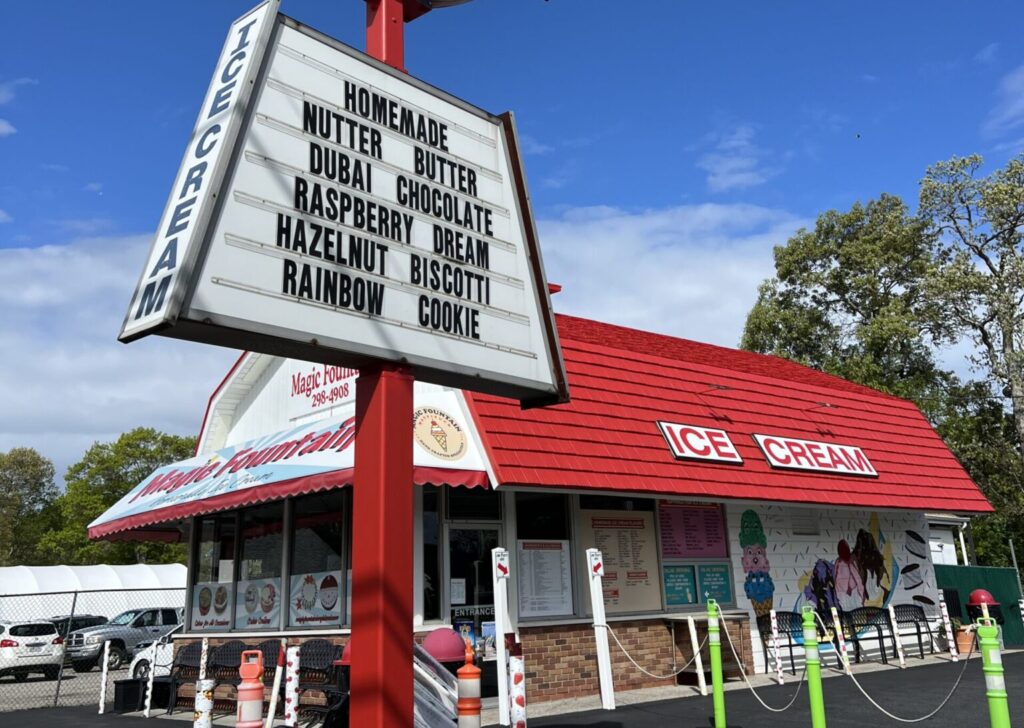‘Secret’ letter found in 18th-century desk

The desk that sits inside the historic Wickham farmhouse on the Village Green in Cutchogue dates to the mid-18th century. But as old as it is, no one knew until May that it contained a private family letter hidden in a secret compartment.
The desk was donated to the Cutchogue-New Suffolk Historical Council, which curates the farmhouse, in 2011 by a member of Cutchogue’s Horton family. It was probably manufactured on Long Island and is made of cherry wood, with a slant top that folds down to form a writing desk.
In May, a woman who knows something about antique furniture, came to the council’s family history day. “I took her on a tour of our buildings on the Village Green,” said Mark MacNish, the council’s executive director. “And I told her about the desk.
“When we got to the desk, it was locked,” he said. “I knew she wanted to see the interior, as it is elaborately crafted. I opened it up. She said, ‘You know, these desks often had secret compartments to hide love letters.’ She reached down with her finger and slid out a secret compartment by one of the cubbyholes and pulled out the letter.
“I looked at it, and I knew it was better than a love letter,” Mr. MacNish added.
The handwritten note is not dated, but Mr. MacNish estimates it was written in the 1930s to 1940s based on the mention of an old Cutchogue street name, Skunk Lane. It is signed “Aunt Jo Horton Cornell” and titled, “The history of the Horton desk as I can describe it.”
The writer goes on to explain that the desk was the property of William Burnette Horton, who “owned a farm extending from the creek to Peconic Bay on ‘Skunk Lane,’ which is the name in old times …”
Her letter says William Horton left Cutchogue “in 1830 or thereabouts” and took his family and furniture to Andersonville, Ga. He “lived there and operated a plantation with slaves until the Civil War was over because the slaves were liberated. He moved back to Peconic and built a new house there,” she explained.
“Aunt Jo” describes how the desk was passed down, Horton to Horton, until it ended up with another William Horton in Cutchogue. And in 2011, Wells Horton donated the desk to the historical council.
The letter — if it is anything more than family lore passed down through the generations with no basis in truth — has caught the eye of locals interested in North Fork history, particularly the stories of the enslaved people who helped build the town before 1827, when slavery ended in New York State.
Until recently, the story of slavery in the region was not a focus of local historians. That changed three years ago when Richard Wines, Amy Folk, Sandi Brewster Walker and the writer of this story formed the North Fork Project to dig into this long-ignored history. A similar project, Plain Sight, is underway in East Hampton, led by David Rattray, publisher of the East Hampton Star.
Since the North Fork Project started, the researchers have found the names of more than 360 men, women and children who were enslaved by North Fork families. No records have been found pertaining specifically to a “William Burnette Horton” before he supposedly moved to Georgia and started a slave plantation.
A reading of the letter dates his departure from Cutchogue to about three years after slavery ended in New York state. He left for Georgia, where it was still flourishing, and moved back to Cutchogue after the Southern slaves “were liberated” with the end of the Civil War in and subsequent ratification of the 13th Amendment in 1865. In other words, his leaving and returning is bracketed by key dates in the history of slavery here and in the Deep South.
“My takeaway is this guy had a business model that relied on free labor,” said Mr. MacNish, who characterized the letter as family lore and not history. “He needed slavery to make his business work. When it ended here, he moved down South where it was still legal.”
The U.S. census slave schedule for 1850 lists a “William B. Horton” living in Georgia and owning three slaves: a 60-year-old female, a 30-year-old female and a 3-year-old male. The 1860 federal slave census shows a “William B. Horton” in Georgia and owning a 75-year-old female. The 1870 census has Horton and his wife living back in what is listed as Peconic.
As with any family document passed down through generations, the information in the letter must be taken with a grain of salt. Family lore does not necessarily translate into actual history. Consider the long-held belief that a family cemetery in Orient contained the remains of the people the family enslaved. Ground penetrating radar proved that story to be wrong – there were no remains of the enslaved there.
Nonetheless — again, if accurate — the Horton letter is a piece in a larger puzzle whose final shape has not been determined.
“Yes, it’s fascinating,” said Ms. Folk, who is also the Southold Town historian. But, as a professional historian, she is cautious. How much of the information in the letter is true? Probably none of it, she said.
“When you get these kinds of letters you have to make sure they are correct,” she said. “You can’t jump to conclusions. For me, it’s problematic.”
Mr. Wines, who has done extensive research into North Fork history, concurred. “So I agree with Amy that the story is probably apocryphal,” he said.
For Mr. MacNish, the letter is another step in his effort to tell a broader story of Cutchogue history. Recently, on behalf of the historical council, he mounted a plaque in the Old House on the Village Green to honor a woman named Keturah, who was enslaved by an owner of the house and lived in the attic. Until that information was made public the existence of enslaved persons in the Old House was willfully ignored.
Keturah, thought to have been born in 1789, was the daughter of enslaved parents, Cyrus and Zipporah, who were owned by Samuel Landon, a Southold town supervisor at one point. In his will, a Jared Landon freed Keturah in 1817. She died in 1867.
“I want to tell the stories of the marginalized people here,” Mr. MacNish said. “I want to feel like we are telling the best possible, most fleshed out history we can tell.”









